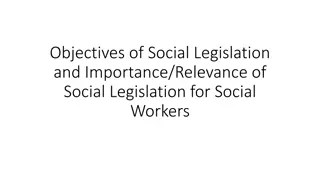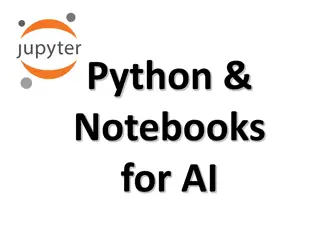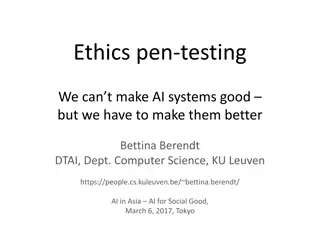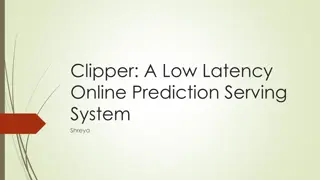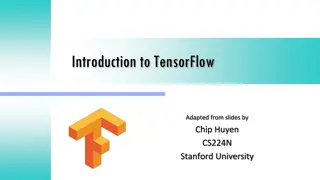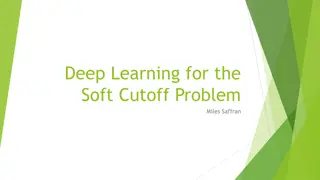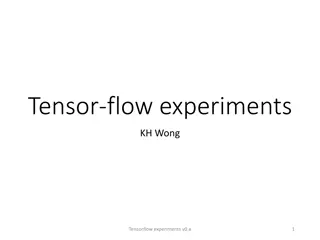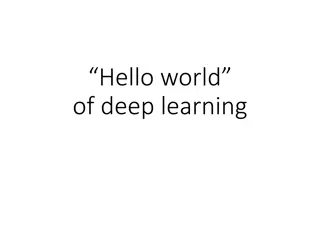Exploring TensorFlow for Social Good: Session Insights and Tips
Delve into Session 3 of TensorFlow for Social Good with Zhixun Jason He, covering topics such as TensorFlow model training loops, regularization techniques, tensor concepts, learning rate scheduling, and custom loss functions. Discover practical tips and valuable resources to enhance your understanding and application of TensorFlow for social impact.
Download Presentation

Please find below an Image/Link to download the presentation.
The content on the website is provided AS IS for your information and personal use only. It may not be sold, licensed, or shared on other websites without obtaining consent from the author. Download presentation by click this link. If you encounter any issues during the download, it is possible that the publisher has removed the file from their server.
E N D
Presentation Transcript
TensorFlow for Social Good Session 3 Zhixun Jason He
Table of Content 1. Review of TensorFlow model training loop 2. How to make the training better (regularization to reduce overfitting) 1. What is Tensor in TensorFlow and its relations to actual training data 2. How to connect actual numbers to Tensor: Keras backend function 3. Learning rate scheduling 4. Add noise and morph on training data 5. Custom loss and training step 3. Tips and resources 1. How to get started 2. Divide and conquer
Links for code snippets Find me: citris.ucmerced.edu/tsg
1 Review of TensorFlow model training loop Training and label data Neural network structure Loss function Start Training and save model
2.1 What is Tensor in TensorFlow and its relations to actual training data 1. A tensor is a placeholder, an element that is used to construct relations and operations a + b = c a, b, d are tensors + and = are the operations or relations a + b = c is a computation graph, a relation between different tensors
2.1 What is Tensor in TensorFlow and its relations to actual training data 1. A tensor is a placeholder, an element that is used to construct relations and operations a + b = c a, b, d are tensors + and = are the operations or relations a + b = c is a computation graph, a relation between different tensors Why we bother to complicate things instead of using the simple concept of variable we learnt from any programming class?
2.1 What is Tensor in TensorFlow and its relations to actual training data 1. A tensor is a placeholder, an element that is used to construct relations and operations a + b = c a, b, d are tensors + and = are the operations or relations a + b = c is a computation graph, a relation between different tensors Why we bother to complicate things instead of using the simple concept of variable we learnt from any programming class? Each tensor is an instance of Tensor class. It includes their unique properties and methods that the TensorFlow framework would like to use during computation.
2.2 How to connect actual numbers to Tensor: Keras backend function After a computation graph is made, all the tensors/placeholders have their relations to each other defined. To actually use this relations to calculate on actual number, it needs to feed the actual number to the computation graph For example, computation graph: a + b = c
2.2 How to connect actual numbers to Tensor: Keras backend function After a computation graph is made, all the tensors/placeholders have their relations to each other defined. To actually use this relations to calculate on actual number, it needs to feed the actual number to the computation graph For example, computation graph: a + b = c Question: How many tensors we have in this computation graph?
2.2 How to connect actual numbers to Tensor: Keras backend function After a computation graph is made, all the tensors/placeholders have their relations to each other defined. To actually use this relations to calculate on actual number, it needs to feed the actual number to the computation graph For example, computation graph: a + b = c Question: How many tensors we have in this computation graph? If we feed actual number to this computation graph, among a, b and c, who are those tensors into which should be fed?
2.2 How to connect actual numbers to Tensor: Keras backend function After a computation graph is made, all the tensors/placeholders have their relations to each other defined. To actually use this relations to calculate on actual number, it needs to feed the actual number to the computation graph For example, computation graph: a + b = c Question: How many tensors we have in this computation graph? If we feed actual number to this computation graph, among a, b and c, who are those tensors into which should be fed? Why we call some tensors as placeholder compared to some regular tensor?
2.2 How to connect actual numbers to Tensor: Keras backend function After a computation graph is made, all the tensors/placeholders have their relations to each other defined. To actually use this relations to calculate on actual number, it needs to feed the actual number to the computation graph For example, computation graph: a + b = c Keras function Thinking about the feeding action, this action takes some inputs After feeding the actual number, the computation graph produces some outputs The inputs and outputs are the essential components for defining a function
2.2 How to connect actual numbers to Tensor: Keras backend function After a computation graph is made, all the tensors/placeholders have their relations to each other defined. To actually use this relations to calculate on actual number, it needs to feed the actual number to the computation graph For example, computation graph: a + b = c Keras function Question: What are the inputs for the feeding action? What are the outputs for the computation graph?
2.2 How to connect actual numbers to Tensor: Keras backend function After a computation graph is made, all the tensors/placeholders have their relations to each other defined. To actually use this relations to calculate on actual number, it needs to feed the actual number to the computation graph For example, computation graph: a + b = c Keras function
2.2 How to connect actual numbers to Tensor: Keras backend function Keras function To use Keras function my_fun outputs: [array([ 1, 12, 103], dtype=int32)]
2.2 How to connect actual numbers to Tensor: Keras backend function What TensorFlow has done for us?
2.2 How to connect actual numbers to Tensor: Keras backend function What TensorFlow has done for us? 1. Multiple [a,b] pairs are being computed within one call of function, easier for hardware acceleration 2. Portability, as we have a computation graph, any devices just need the graph to duplicate the same results
2.3 Learning rate scheduling Learning rate ? 1st training step ?? ??(?) a ?(?)
2.3 Learning rate scheduling Learning rate ? 1st training step 2nd training step ?? ??(?) a ?(?)
2.3 Learning rate scheduling Learning rate When the scale of each learning step is too large, at the later stage of training, the parameter s value will bounce back and forth and never settles at the optimal position ? 1st training step 2nd training step ?? ??(?) a ?(?)
2.3 Learning rate scheduling Learning rate When the scale of each learning step is too large, at the later stage of training, the parameter s value will bounce back and forth and never settles at the optimal position ? 1st training step 2nd training step ?? ??(?) So how about we set the learning rate very small from the beginning? a ?(?)
2.3 Learning rate scheduling Learning rate When the scale of each learning step is too large, at the later stage of training, the parameter s value will bounce back and forth and never settles at the optimal position ? 1st training step 2nd training step ?? ??(?) So how about we set the learning rate very small from the beginning? a ?(?) Then the training is going to be very slow
2.3 Learning rate scheduling Learning rate When the scale of each learning step is too large, at the later stage of training, the parameter s value will bounce back and forth and never settles at the optimal position So how about we set the learning rate very small from the beginning? Then the training is going to be very slow
2.3 Learning rate scheduling Learning rate When the scale of each learning step is too large, at the later stage of training, the parameter s value will bounce back and forth and never settles at the optimal position So how about we set the learning rate very small from the beginning? Then the training is going to be very slow
2.3 Learning rate scheduling Learning rate Code snippet
2.4 Add noise and morph on training data To encourage the model learns the latent feature of the data instead of memorizing the variety in the data set, modifying training data slightly during training can prevent overfitting and add regularization to the learning process. Many times, the noise and morph applied to the training data will increase the model s performance after training.
2.4 Add noise and morph on training data To encourage the model learns the latent feature of the data instead of memorizing the variety in the data set, modifying training data slightly during training can prevent overfitting and add regularization to the learning process. Many times, the noise and morph applied to the training data will increase the model s performance after training.
2.4 Add noise and morph on training data Data augmentation: e.g., for image data: horizontal flip width shift height shift self-reflect add random Gaussian noise
2.4 Add noise and morph on training data Implementation in Python
2.4 Add noise and morph on training data Implementation in Python Note: Data augmentation is inactive at test time so input images will only be augmented during calls to Model.fit (not Model.evaluate or Model.predict)
2.5 Custom loss and training step Customize training step, define custom model by subclassing the TensorFlow Model class.
2.5 Custom loss and training step Customize training step, define custom model by subclassing the TensorFlow Model class.
2.5 Custom loss and training step Define custom training step
2.5 Custom loss and training step Define custom training step. Note that we have full control on how loss and acc are calculated.
2.5 Custom loss and training step Define custom training step. Note that we have full control on how loss and acc are calculated, e.g., acc: y_true and p_pred are one-hot vector, e.g., for 3-way category the vector looks like [0, 0, 1] argmax will turn [0, 0, 1] into [2] (the index of 1 in the one-hot vector, which has three indices: 0, 1, 2)
2.5 Custom loss and training step Monitoring performance through metrics:
3 Tips and resources 3.1 How to get started Use a handy Integrated Development Environment (IDE), e.g., Pycharm (free for students) to organize your project and individual script Get ourselves used to searching questions and reading tutorials, such as https://www.tensorflow.org/tutorials, search question on Google, read answers from stack overflow( https://stackoverflow.com/) Clone a runnable script to your local machine, run it, read it and digest it. Pay attention to different styles of implementation and see the similarities and differences 3.2 Divide and conquer Use IDE to track down which line of code gives error If project is large, comment out big chuck of the project to pinpoint which line starts causing problem If not sure about certain things, write a separate piece of code with the simplest and leanest possible code to see what exactly happened. The benefit of the leanest code snippet is that you can post it online, ask help from others, and the leanest the code is, the faster you will get a response from other people








